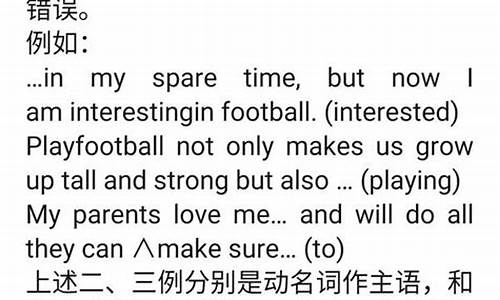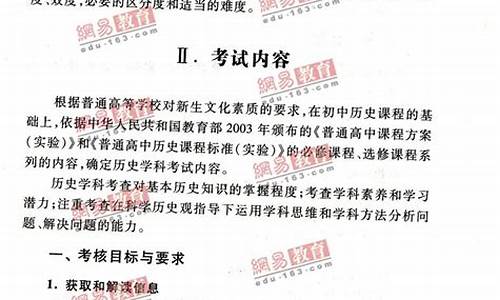您现在的位置是: 首页 > 教育研究 教育研究
2017年高考试卷答案_2017年高考卷3答案
tamoadmin 2024-05-20 人已围观
简介归纳总结高考概率大题的常见概率模型及求解策略能够帮助学生快速识别概率大题题型模式,并有针对性地选择解题方法,快速准确解决高考概率大题下面是我为你整理关于17年高考概率题解题技巧的内容,希望大家喜欢! 17年高考概率题解题技巧 (一)直接计算 在考试当中这属于比较简单的一类题目,直接计算就是将题干直接转述成公式来求解。我们举个例子: 例1从3双完全相同的鞋中,随机抽取一双鞋的概率是:( )

归纳总结高考概率大题的常见概率模型及求解策略能够帮助学生快速识别概率大题题型模式,并有针对性地选择解题方法,快速准确解决高考概率大题下面是我为你整理关于17年高考概率题解题技巧的内容,希望大家喜欢!
17年高考概率题解题技巧
(一)直接计算
在考试当中这属于比较简单的一类题目,直接计算就是将题干直接转述成公式来求解。我们举个例子:
例1从3双完全相同的鞋中,随机抽取一双鞋的概率是:( )
A.B.
C.D.
答案B
解析总的情况数为,再求出满足条件的情况数即可,抽取的两只鞋正好是一双,所以情况数为,所以所求的概率为。
(二)分类分步计算
所谓的分类计算指的是将满足条件的各种情况的概率加和运算;而分步计算指的是将满足条件的每个步骤概率作乘积运算。这与我们之前将到的排列组合中的2个原理:分类与分步是一致的。我们通过举例子来学习:
例2某高校从E、F和G三家公司购买同一设备的比例分别为20%,40%和40%,E、F和G三家公司所生产设备的合格率分别为98%,98%和99%,现随机购买到一台次品设备的概率是:( )
A.0.013 B. 0.015
C.0.016 D. 0.01
答案C
解析次品可能是从E、F、G三家公司购买到的,这时候只要把三者的概率加起来即可:。
(三) 逆向计算
当遇到求概率的题目,从正面求解遇到困难的话可以考虑通过求其反向来得到结果,这就是逆向计算,公式为:某条件满足的概率=1-不满足该条件的概率。举个例子:
例3小王开车上班需经过4个交通路口,假设经过每个路口遇到红灯的概率分别为0.1、0.2、0.25、0.4,则他上班经过4个路口至少有一处遇到绿灯的概率是( )
A.0.899 B.0.988
C.0.989 D.0.998
答案D
解析这个题目如果正面求解的话比较繁琐,因为至少一次绿灯的可能性就有4种,在这四种可能性中有分为几种情况,计算不现实,所以考虑使用逆向思维来求解,即求出其反面——没有遇到一次绿灯,也就是说遇到的全是红灯。全部遇到红灯的概率为,所以逆向计算结果为1-0.002=0.998。
高考数学临场应考8招第一部分进场前后
进入考场的前后,主要是做好心理准备、物质准备、体力准备和发挥准备。
第1招:提前进入角色。
具体要做到:
(1)考前调整,休养生息。
考生在考前一两周应逐渐放松,进入静息状态,并进行生物钟的调整,让作息时间安排得与高考的时间同步,在这段时间内,要保持情绪稳定,降低学习强度,增加睡眠时间,进行轻微活动,熟悉考场细则,做好物质准备,在一种宁静的气氛中主要做识记性的复习工作(勿做难题、偏题、怪题)。比如,回想学科的整体结构,舒展脉络,背诵其中的重点内容(如二项式定理、等差、比数列通项公式、求和公式、圆锥曲线标准方程等)。发现有漏缺是不要焦急,应从容不迫地坐下来翻阅教材和笔记,保持内紧外松。“静能生慧”,经过强化训练之后的静息,是记忆恢复的最佳选择,许多发明创造都是在“脑风暴”之后的冷却期出现的,临考前必要的静息,看似失去,实为获得。
(2)熟悉考场,备份清单。
考生一定要亲临考场(特别是考场未设在本校的考生),熟悉环境,记下来回的路线和行走的时间,认准卫生间和医疗室的位置,一方面可以消除所谓的“新异刺激”,另一方面也能“以防万一”。
临考当天,应有充足的睡眠,并吃好清淡的早餐和带齐考试用品。
(3)提前活动,进入角色。
应提前半个多小时到达考场,一方面防止路上出现意外,另一方面可以稳定情绪,让脑细胞开始简单的数学活动,让大脑进入单一的数学情境。如:清点所需用具是否齐全、把一些基本数据、常用公式、重要定理“过过**”,特别是一些自己认为难记易忘的结论等。
第2招:迅速摸清“题情“
刚拿到试卷,一般心情比较紧张,思考亦为进入高潮,此时不要匆忙作答,可以从头到尾、正反两面通览一遍试卷,弄清全卷共有几页、几题?看看页码是否齐全?答卷是否配套?印刷是否完整、清晰?尤其要认真阅读试卷的说明与各题的指导语。
(1)通览全卷的作用。
首先,一份试卷,相当于一份学科复习提纲,有了试卷的全貌认识,可使我们有机会从整体结构上获得积极的暗示,便于从学科的知识体系上产生联想,激活记忆,提高分析问题的能力和解决问题的效率。其次,可以为实施正确的答题策略提供尽可能多的客观基础。再次,便于统筹安排时间,防止个别小题上纠缠过久,也能有效克服“前面难题久攻不下,后面易题无暇顾及”的毛病。最后,可以提前防止缺页、残页、空白页,也能从根本上避免漏做题。
(2)通览全卷的基本工作。
通览全卷即是摸清“题情”,又是解题的第一个循环,一般可在不到10分钟的时间内完成4件事。其一,填卷首、看说明、两写三涂。其二,顺手解答。即顺手解答那些一眼看得出结论的简单的选择题、填空题,显然,看完全卷比只看开头两三道题更容易找到熟悉的内容,更容易找到会做的题目;而只要能很快解答出一两道题(每套试卷都会有难度系数0.8以上的热身题),情绪就会迅速稳定下来,并且“旗开得胜”的愉悦感还有一种增力作用,能鼓励自己去作更充分的发挥。其三,粗略分类。其四,做到三个心中有数。即要对题量心中有数、要对题分心中有数、要对题目内容的分量心中有数。
第二部分答题要领
通览全卷之后,思考逐渐进入高潮,建议掌握好三个答题要领。
第3招:三轮答题。
就是说,完整解答一套试题可经过3个循环(三轮答题法)。一头一尾是两个小循环,各用10分钟左右,中间是一个大循环,用将近100分钟。
第一循环:通览全卷,先做简单的第一遍解答,这是一个小循环。按高考题的难度系数比例3:5:2计算,可以先从那30? ro容易题入手,获四五十分;同时,把情绪稳定下来,将思考推向高潮。
第二循环:全面解答,即用将近100分钟的时间,基本完成全卷,会做的都做了。在这个大循环中,要有全局意识,能作整体把握,并执行“四先四后”(参见第4招)、“一慢一快”(参见第5招)的方针。
第三循环:复查收尾,即用大约10分钟的时间来检查解答过程并实施“分段得分”(参见第16~20招)。对于绝大多数考生来说,都不可能在第二循环中答全答对所有的试题,因此要对那些答不全或答不对的题目进行技术性处理。这一步的作用有点像足球守门,把住最后一关。即使都做完了的题目,也要复查,防止“会而不对、对而不全”,这一步是超水平发挥,争取多得分的不可缺少的步骤。
第4招:四先四后。
考虑到满分卷是极少数,绝大多数考生,都只能答对部分题目或题目的部分,因此,执行“四先四后”的技术措施是明智的。
(1)先易后难。
(2)先熟后生。
(3)先高后低。就是说要优先处理高分题(解答题),特别是在考试的后半段时间,更要注意解题的时间效益。
(4)先同后异。
第5招:一慢一快。
就是说,审题要慢,解题要快。
其中,审题要慢具体要抓好审题的“三个要点,四个步骤”。即:
要点1:弄清题目的条件是什么,一共有几个,其数学含义如何。
要点2:弄清题目的结论是什么,一共有几个,其数学含义如何。
要点3:弄清题目的条件和结论有哪些数学联系,是一种什么样的结构。
步骤1:读题——弄清字面含义。
步骤2:理解——弄清数学含义。
步骤3:表征——识别题目类型。
步骤4:深化——接近深层结构。
再次,书写要快。首先,在宏观上要有争分夺秒的速度意识,因为高考本身有时间的限制,有速度要求。据统计,一套高考数学卷通常控制在2000个左右的印刷符号,若以每分钟阅读300~400个印刷符号的速度审题,约需5~7分钟,考虑到有的题目要反复阅读,实际需要12分钟,书写主要用于解答题,约3000个印刷符号,按每分钟150个印刷符号的速度书写,约需28分钟,也就是说,看清题目后直接抄标准答案都需要40分钟,留给思考、草算、文字组织和复查检验的时间只有80分钟,平均每一问(通常是每卷都有21只22道题,约30问),保证不了3分钟,为了给解答题留下思考的时间,选择题、填空题就只能在一二分钟内解决,解决不了的就先跳过去(被跳过的题目其实还在潜意识里继续思考);解答题中容易的题也不妨边想边写,节省草算时间,一般地,选择题、填空题与解答题的时间比可分配为3.5:6.5.其次,具体到每一题,一旦找到解题思路,书写要简明扼要、快速规范,不要拖泥带水,罗嗦重复,更别画蛇添足(导致倒扣分),用阅卷教师的行话来说,就是要写出“得分点”,就数学题而言,一个原理写一步就可以了,至于不是题目要直接考查的过度知识,特别是那些初中知识,可以直接写出结论,须知,多写一步就是多出现一个犯错的机会,就是多占用了后面高分题的一点思考时间,这就意味着“隐含失分”或“潜在丢分”。为了节约书写,建议多使用数学语言、集合符号、充要条件。
第三部分全局意识
高考并不是按满分录取的,也没有单科的最低录取控制线。因此,部分题目失分、个别科目未考好并不影响录取,关键是加总分能进入录取线,上述“四先四后”已经体现了临场的全局意识,此外还有3条建议。
第6招:立足中下题目。力争高上水平。
应该看到,中下题目通常占全卷的80%(计120分),是试卷构成的主要成分,是考生得分的主要来源,是高校录取的主要依据,并且还是进一步解高难度题得基础。我们说“前120分若能稳拿,后30分就更有希望了”。确实,考生若能攻下全部中下档题目,稳拿120分,应该认为这已经打了一个打胜仗。已经获得了一个成功的奖赏,它为后面攻克高难题准备了时间和心理能量,更容易超水平发挥,退一步说,各科的难题都做不了,仅凭80%的得分率(总分可得750x0.8=600分),录取通知书也已遥遥在望了。相反,若因为还有二三十分的题做不出来(满分150分),感到紧张、焦急,总想全做全对,就只会更加发挥不好,甚至忙中出错,把本来做对的地方也改错了(检查中遇到两种解法,没把握时,可优先尊重第一选择,相信第一感觉)。应该知道,高考是加总分录取的,它是依据相对分数的优势从前往后选择的。就像奥运会比赛,关键不是破世界纪录,而是得金牌,当然,既得金牌又破记录是一件两全其美的好事,但对大多数考生来说,要害是“考上”!要确保基础分,拿下力争分,不丢零碎分。
第7招:立足一次成功,重视复查环节。
高考的时间很紧张,不可能做大量细致的解后检验。所以,答题要立足一次成功,稳打稳扎,字字准确,步步有据,努力提高解题的成功率,最好是每进行一步书写时,都用眼睛的余光扫视上下两行,顺便检验有无差错(步步检验)!
第8招:内紧外松。
考试的始终,不宜过分紧张,也不要漫不经心,要有适度的紧迫感和强烈的使命感,又要防止过分焦虑和患得患失,做到坚定、清醒、沉着、从容,叫做“内紧外松”。没有紧迫感就没有最佳竞技状态。这里说的紧迫感主要指考试过程中要放得开,挺得住,精神集中,心态平和,勇于自我鼓励,善于自我暗示,同时还表现为时间观念、速度意识和遇到困难时的信心、勇气、毅力与不屈不挠,应该认识到,个别题目不会做(或来不及做),有的科目未发挥出应有的水平等都属于正常现象(不必大惊小怪、更别惊慌失措),都要以内紧外松的态度坚持考好每一科,坚持做好每一题,坚持用好每一秒(答题顺利时也别提前交卷),绝不能中途泄气。比如,遇到数学解答题较难、思维受阻的情形较多时,就要在心里暗示自己:不是自己一个人不会做,大家都难,拿不下来并不影响录取,“我易人易莫大意,我难人难不畏难”。从全局上看,高考是加总分录取的,不在乎一题一科的得失,越是在困难的时候越是要有全局意识,越是要想到“东方不亮西发亮,暗了北方有南方”,必要时可以闭目养一养神,或做一做深呼吸。
数学高考答题技巧六种1.调整好状态,控制好自我。
(1)保持清醒。数学的考试时间在下午,建议同学们中午最好休息半个小时或一个小时,其间尽量放松自己,从心理上暗示自己:只有静心休息才能确保考试时清醒。
(2)按时到位。今年的答题卡不再单独发放,要求答在答题卷上,但发卷时间应在开考前5-10分钟内。建议同学们提前15-20分钟到达考场。
2.通览试卷,树立自信。
刚拿到试卷,一般心情比较紧张,此时不易匆忙作答,应从头到尾、通览全卷,高中物理,哪些是一定会做的题要心中有数,先易后难,稳定情绪。答题时,见到简单题,要细心,莫忘乎所以。面对偏难的题,要耐心,不能急。
3.提高解选择题的速度、填空题的准确度。
数学选择题是知识灵活运用,解题要求是只要结果、不要过程。因此,逆代法、估算法、特例法、排除法、数形结合法尽显威力。12个选择题,若能把握得好,容易的一分钟一题,难题也不超过五分钟。由于选择题的特殊性,由此提出解选择题要求快、准、巧,忌讳小题大做。填空题也是只要结果、不要过程,因此要力求完整、严密。
4.审题要慢,做题要快,下手要准。
题目本身就是解除这道题的信息源,所以审题一定要逐字逐句看清楚,只有细致地审题才能从题目本身获得尽可能多的信息。
找到解题方法后,书写要简明扼要,快速规范,不拖泥带水,牢记高考评分标准是按步给分,关键步骤不能丢,但允许合理省略非关键步骤。答题时,尽量使用数学语言、符号,这比文字叙述要节省而严谨。
5.保质保量拿下中下等题目。
中下题目通常占全卷的80%以上,是试题的主要部分,是考生得分的主要来源。谁能保质保量地拿下这些题目,就已算是打了个胜仗,有了胜利在握的心理,对攻克高难题会更放得开。
6.要牢记分段得分的原则,规范答题。
会做的题目要特别注意表达的准确、考虑的周密、书写的规范、语言的科学,防止被分段扣点分。
难题要学会:
(1)缺步解答:聪明的解题策略是,将它们分解为一系列的步骤,或者是一个个小问题,能解决多少就解决多少,能演算几步就写几步。特别是那些解题层次明显的题目,或者是已经程序化了的方法,每进行一步得分点的演算都可以得分,最后结论虽然未得出,但分数却已过半。
(2)跳步答题:解题过程卡在某一过渡环节上是常见的。这时,我们可以假定某些结论是正确的往后推,看能否得到结论,或从结论出发,看使结论成立需要什么条件。如果方向正确,就回过头来,集中力量攻克这一卡壳处。如果时间不允许,那么可以把前面的写下来,再写出证实某步之后,继续有一直做到底,这就是跳步解答。也许,后来中间步骤又想出来,这时不要乱七八糟插上去,可补在后面。若题目有两问,第一问想不出来,可把第一问作已知,先做第二问,这也是跳步解答。今年仍是网上阅卷,望广大考生规范答题,减少隐形失分。
?
许多在眼前看来天大的事,都不是人生一战,而只是人生一站。确实高考备战让你们很辛苦,可是已经坚持了这么久,这就已经是胜利。祝高考成功!下面是我为大家推荐的河北英语高考题2017年,仅供大家参考!
河北英语高考题2017年第I卷
注意事项:
1.答第I卷前,考生务必将自己的姓名、准考证号填写在答题卡上
2.选出每小题答案后,用2B铅笔把答题卡上对应题目的答案标号涂黑。如需改动,用橡皮擦干净后,再选涂其他答案标号。不能答在本试卷上,否则无效
第一部分听力(共两节,满分30分)
做题时,先将答案标在试卷上,录音内容结束后,你将有两分钟的时间将试卷上的答案转涂到答题卡上
第一节(共5小题;每小题1.5分,满分7.5分)
听下面5段对话。每段对话后有一个小题,从题中所给的A、B、C三个选项中选出最佳选项,并标在试卷的相应位置。听完每段对话后,你都有10秒钟的时间来回答有关小题和阅读下一小题题。每段对话仅读一遍。
例:How much is the shirt?
A.£19.15. B.£9.18. C.£9.15.
答案是C。
1. Where is Mary?
A. In the classroom. B. In the library. C. On the playground.
2. How much should the man pay for the tickets?
A. $16. B. $12. C. $6
3. Why can?t the woman give the man some help?
A. She is quite busy now.
B. She doesn?t like grammar.
C. She is poor in grammar,too.
4. What happened to Marx?
A. He lost his way.
B. He found his bike missing.
C. He lost his wallet.
5. Why did the man fail to attend the party?
A. He forgot it.
B. He didn?t know about the party.
C. He wasn?t invited to the party.
第二节(共15小题;每小题1.5分,满分22.5分)
听下面5段对话或独白。每段对话或独白后有几个小题,从题中所给的A、B、C三个选项中选出最佳选项,并标在试卷的相应位置。听每段对话或独白前,你将有时间阅读各个小题,每小题5秒钟;听完后,各小题将给出5秒钟的作答时间。每段对话或独白读两遍。
听第6段材料,回答第6、7题。
6. Why must the man drive to work?
A. It is the quickest way.
B. He has to use his car after work.
C. He lives too far from the subway.
7. What?s the relationship between the speakers?
A. Boss and employee.
B. Grandmother and grandson.
C. Teacher and student.
听第7段材料,回答第8~9题。
8. When is Alice?s birthday?
A. Tomorrow. B. The day after tomorrow. C. Today.
9. What will the two speakers buy for Alice?
A. A recorder. B. Some flowers. C. A box of chocolates.
听第8段材料,回答第10~12题。
10. What does the woman do in the group?
A. Play the piano. B. Play the violin. C. Sing for the group.
11. Who is Miss Pearson?
A. Leader of the group.B. Director of the group. C. Teacher of the group.
12. How often does the group meet?
A. Once a week. B. Twice a week. C. Every third week.
听第9段材料,回答第13~16题。
13. Who possibly is the woman?
A. An air hostess. B. A native Indian. C. A travel agent.
14. How long does the trip last?
A. Seven days. B. Eight days. C. Nine days.
15. What will the man probably do at the second stage?
A. Do some shopping. B. Visit the Taj Mabal. C. See wild animals.
16. What will the speakers do next?
A. Say goodbye to each other.B. Find out the price. C. Go to India by air.
听第10段材料,回答第17~20题。
17. In what way does Jack like to travel?
A. With a lot of people.
B. With one or two good friends.
C. All by himself.
18. What does Helen prefer on holiday?
A. Staying at home.
B. Seeing famous places.
C. Enjoying nature quietly.
19. What does Bob like the best about travel?
A. Making more friends. B. Buying what he wants. C. Seeing and learning.
20. Who prefers to do shopping while traveling?
A. Jack. B. Helen. C. Bob.
第二部分阅读理解(共两节,满分40分)
第一节(共15小题;每小题2分,满分30分)
阅读下列短文,从每题所给的四个选项(A、B、C和D)中,选出最佳选项,并在答题卡上将该项涂黑。
A
We have designed all our bank cards to make your life easier.
Using your NatWest Service Card
As a Switch card, it lets you pay for all sorts of goods and services, whenever you see the Switch logo. The money comes straight out of your account, so you can spend as much as you like as long as you have enough money (or an agreed overdraft (透支) to cover it). It is also a cheque guarantee card for up to the amount shown on the card. And it gives you free access to your money from over 31,000 cash machines across the UK.
Using your NatWest Cash Card
You can use your Cash Card as a Solo card to pay for goods and services wherever you see the Solo logo. It can also give you access to your account and your cash from over 31,000 cash machines nationwide. You can spend or withdraw what you have in your account, or as much as your agreed overdraft limit.
Using your cards abroad
You can also use your Service Card and Cash Card when you?re abroad. You can withdraw cash at cash machines and pay for goods and services wherever you see the Cirrus or Maestro logo displayed.
We take a commission charge (手续费) of 2.25% of each cash withdrawal you make (up to£4) and a commission charge of 75 pence every time you use Maestro to pay for goods or services. We also apply a foreign-exchange transaction fee of 2.65%.
Using your NatWest Credit Card
With your credit card you can do the following:
* Pay for goods and services and enjoy up to 56 days? interest-free credit.
* Pay in over 24 million shops worldwide that display the MasterCard or Visa logos.
* Collect one AIR MILE for every£20 of spending that appears on your statement (结算单). (This does not include foreign currency or traveler?s cheques bought, interest and other charges.)
21. If you carry the Service Card or the Cash Card, ________.
A. you can use it to guarantee things as you wish
B. you can draw your money from cash machines conveniently
C. you can spend as much money as you like without a limit
D. you have to pay some extra money when you pay for services in the UK
22. If you withdraw£200 from a cash machine abroad, you will be charged ________.
A. £4 B. £4.5 C. £5.25 D. £5.3
23. Which of the following is TRUE about using your NatWest Credit Card?
A. You have to pay back with interest within 56 days.
B. You can use the card in any shop across the world.
C. You will be charged some interest beyond two months.
D. You will gain one air mile if you spend £20 on traveller?s cheques.
24. The purpose of the passage is to show you how to ________.
A. pay for goods with your cards B. use your cards abroad
C. draw cash with your cards D. play your cards right
B
Once when I was facing a decision that involved high risk, I went to a friend. He looked at me for a moment, and then wrote a sentence containing the best advice I?ve ever had: Be bold and brave ? and mighty (强大的) forces will come to your aid.
Those words made me see clearly that when I had fallen short in the past, it was seldom because I had tried and failed. It was usually because I had let fear of failure stop me from trying at all. On the other hand, whenever I had plunged into deep water, forced by courage or circumstance, I had always been able to swim until I got my feet on the ground again.
Boldness means a decision to bite off more than you can eat. And there is nothing mysterious about the mighty forces. They are potential powers we possess: energy, skill, sound judgment, creative ideas ? even physical strength greater than most of us realize.
Admittedly, those mighty forces are spiritual ones. But they are more important than physical ones. A college classmate of mine, Tim, was an excellent football player, even though he weighed much less than the average player. ?In one game I suddenly found myself confronting a huge player, who had nothing but me between him and our goal line,? said Tim. ?I was so frightened that I closed my eyes and desperately threw myself at that guy like a bullet ? and stopped him cold.?
Boldness ? a willingness to extend yourself to the extreme?is not one that can be acquired overnight. But it can be taught to children and developed in adults. Confidence builds up. Surely, there will be setbacks (挫折) and disappointments in life; boldness in itself is no guarantee of success. But the person who tries to do something and fails is a lot better off than the person who tries to do nothing and succeeds.
So, always try to live a little bit beyond your abilities?and you?ll find your abilities are greater than you ever dreamed.
25. Why was the author sometimes unable to reach his goal in the past?
A. He faced huge risks. B. He lacked mighty forces.
C. Fear prevented him from trying. D. Failure blocked his way to success.
26. What is the implied meaning of the underlined part?
A. Swallow more than you can digest. B. Act slightly above your abilities.
C. Develop more mysterious powers. D. Learn to make creative decisions.
27. What can be learned from Paragraph 5?
A. Confidence grows more rapidly in adults. B. Trying without success is meaningless.
C. Repeated failure creates a better life. D. Boldness can be gained little by little.
C
The wallet is heading for extinction. As a day-to-day essential, it will die off with the generation who read print newspapers. The kind of shopping-where you hand over notes and count out change in return?now happens only in the most minor of our retail encounters,like buying a bar of chocolate or a pint of milk from a corner shop. At the shops where you spend any real money, that money is increasingly abstracted. And this is more and more true, the higher up the scale you go. At the most cutting-edge retail stores?Victoria Beckham on Dover Street, for instance?you don't go and stand at any kind of cash register when you decide to pay. The staff are equipped with iPads to take your payment while you relax on a sofa.
Which is nothing more or less than excellent service, if you have the money. But across society, the abstraction(抽象) of the idea of cash makes me uneasy. Maybe I'm just old-fashioned. But earning money isn't quick or easy for most of us. Isn't it a bit incredible that spending it should happen in half a blink(眨眼)of an eye? Doesn't a wallet?that time-honoured Friday-night feeling of pleasing, promising fatness?represent something that matters?
But I'll leave the economics to the experts. What bothers me about the death of the wallet is the change it represents in our physical environment. Everything about the look and feel of a wallet?the way the fastenings and materials wear and tear and loosen with age, the plastic and paper and gold and silver, and handwritten phone numbers and printed cinema tickets?is the very opposite of what our world is becoming. The opposite of a wallet is a smartphone or an iPad. The rounded edges, cool glass, smooth and unknowable as pebble(鹅卵石). Instead of digging through pieces of paper and peering into corners, we move our fingers left and right. No more counting out coins. Show your wallet, if you still have one. It may not be here much longer.
28. What is happening to the wallet?
A. It is disappearing. B. It is being fattened.
C. It is becoming costly. D. It is changing in style.
29. What makes the author feel uncomfortable nowadays?
A. Saving money is becoming a thing of the past.
B. The pleasing Friday-night feeling is fading.
C. Earning money is getting more difficult.
D. Spending money is so fast and easy.
30. Why does the author choose to write about what's happening to the wallet?
A. It represents a change in the modern world.
B. It has something to do with everybody's life.
C. It marks the end of a time-honoured tradition.
D. It is the concern of contemporary economists.
31. What can we infer from the passage about the author?
A. He is resistant to social changes.
B. He is against technological progress.
C. He feels reluctant to part with the traditional wallet.
D. He feels insecure in the ever-changing modern world.









